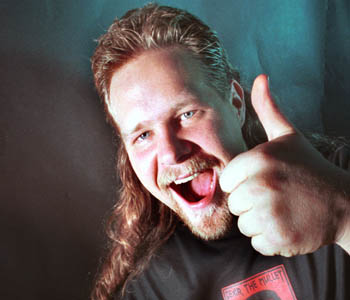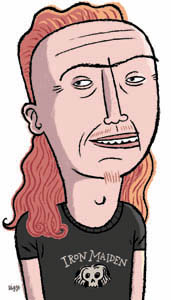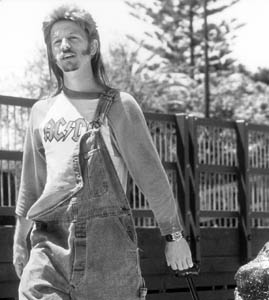![[Metroactive Features]](http://metroactive.com/features/gifs/feat468.gif)
[ Features Index | San Jose | Metroactive Central | Archives ]
This Mullet's for You: Metro Art Director Shannon Stillman in the haircut he wore for two days.
Bi-Level Curious
It's the subject of more than a dozen websites, an illustrated book, a documentary, a Beastie Boys song, theme parties and a budding cottage industry. Why does the mullet haircut inspire such devotion and derision?
By Will Harper
Even for a National Hockey League game, the brood assembled in the San Jose Arena's high elevation, upper-concourse-level seats--where loss of cabin pressure is a risk--was acting particularly goofy.
Mind you, Sharks games do not promote rational behavior to begin with. A group psychosis regularly takes over, where full-grown adults wearing $50 hockey jerseys make furious arm motions called "the chomp," a movement meant to simulate a shark bite, but more closely resembling a pair of rusty salad tongs.
But this night, chompers had nothing on these other loud kooks, who kept yelling out a word commonly associated with a fish, yes, but not a shark.
"Give me an 'M'" shouted the ringleader, holding an upside-down Canadian flag.
"Emmm," his cohorts shouted back.
"Give me a 'U'!"
"Uuuuu."
"Give me an 'L,L'!"
"L! L! "
"Give me an 'E,T'!"
"E-T!"
"Give me an 'S'!"
"Esssssss!"
"What's that spell?"
"MULLETS," everyone rejoiced in unison.
Nearby fans shifted in their chairs, trying to focus on the game on the ice, avoiding eye contact with the strange people above. Soon, an arena usher wearing an electric-blue jacket began climbing up the stairs to see if these people had tickets.
They were indeed a suspicious-looking cast of characters:
One wore a stained "30 and Dirty" baseball cap, the kind found at truck stops along rural parts of Interstate 5. Another, afflicted with unibrow, wore a scarf-wrap on his head like the Muslims do. Then there was a quasi-Cholo with a bandana and another in soccer shorts and a warm-up jacket.
And all 25 of them had roughly the same hairstyle: short hair in front and on top, with long hair covering their necks and trailing down their backs.
In reality, none of these characters actually had neck-warmer hair. That was just part of the costume, which the herd of Santa Clara University students wore as part of a theme party dedicated to a hairstyle called the mullet.
And what better place to have a party for the hairstyle sometimes referred to as "hockey hair" than at a Sharks game?
The clever party-goers fashioned their mullets using fake beard hair, which they tucked underneath a hat or other headgear. According to Dane Thompson, one of the ringleaders, none of the costumes cost anyone more than $10.
Arena security wasn't amused. A guard confiscated their video camera. Mike Paye, another participant, later groused, "Because we had mullets, they discriminated against us."
After the game, the mullet crew boarded Caltrain to head back to their fort near the Jesuit-run university. While making a pit stop at the Safeway on The Alameda, they stumbled across a wondrous sight: A real mullet in his natural habitat.
His name was Paul and he was probably in his early 30s. His wavy blonde wisps warmed his neck, but his ears remained exposed to the elements in the produce section. While he didn't carry a twelver of Bud, he clearly was cradling a 16-plus-ounce hunk of steak, known to be a mullet delicacy.
Overwhelmed by curiosity, the party-goers circled Paul and complimented him on his 'do. "Where are you guys from?" the bewildered shopper asked.
"MulletsGalore.com," one of them lied, referring to a popular mullet-mocking website.
"Are you guys hiring?" Paul asked.
The response? "We love you, Paul."
THE MULLET, believe it or not, has a cult following that's growing faster than a set of freshly cut bangs.
More precisely, mullet mocking has taken college campuses and the Internet by storm. The hairstyle itself, crafted in the 1970s as the world was making its transition from hippiedom into punkdom, is by no means making a comeback. Even crooner Michael Bolton has trimmed his trademark blonde mane.
In the past couple of years, more than a dozen mullet websites have surfaced--often crafted by computer-savvy college kids or sarcastic twenty-somethings--to make fun of the hairstyle and, by association, of the culture that champions the look.
There's MulletsGalore.com, MulletMadness.com, MulletJoe.com, MulletJunky.com, MulletGods.com, Dan's Mullet Haven and the North American Mullet Page (the granddaddy of all the sites).
There's even a site that rates and reviews other mullet-oriented sites (www.mulletlinks.com).
The sites all study and analyze mullet-wearers the way Jane Goodall monitors the behavior of chimps.
MulletsGalore, MulletJunky and the North American Mullet Page have dozens of sociological classifications for mullet-wearers, from "business mullet" (a mullet wearing a tie) to "mullatino" (Latino with a mullet), "mulletard" (the developmentally disabled mullet), granola mullet (hippie with a mullet), "skullet" (bald in front, long in back), "femullet" (girl with a mullet), which isn't to be confused with the "dyke mullet" (no explanation needed).
MulletsGalore, the most wickedly funny of all the sites, coined the phrase "mulletude" to describe "the attitude that comes with the adornment of the mullet." And they've spared no stereotype or pet peeve.
"Behaviors can include the following: beating one's spouse, scowling or sneering at those who don't have mullets, engaging in fights on a regular basis (preferably with those who are not part of the mullet brotherhood) ... listening to butt-rock, attending monster truck rallies, driving a Chevrolet Camaro (model years 1970-1993) or mini-truck, snorting crank, working in construction ... speaking in an inappropriately loud voice."
The sites have spawned a legion of what are often called "mullet hunters," people armed with cameras who surreptitiously snap photos and send them in to be posted online and ridiculed.
"Few things bring more pleasure and inner peace than observing mullets in their natural habitat," the Mullet Madness site promises. "Imagine a triple-decker buying a pack of smokes at the local gas station while refueling his Camaro, or a whole family of mullets fighting over the chicken-fried steaks at your neighborhood chuck-a-rama."
According to Ryan Noble, the 22-year-old proprietor of MulletJoe and MulletLinks, the mullet sites get a lot of traffic.
Noble, a recent grad from Washington and Lee University in Virginia who now runs his own web design company in Illinois, boasts that his site gets 10,000 hits a day. Thirty percent of the traffic comes from universities, Noble says. A writer for MulletMadness.com estimates his site gets anywhere from 3,500 to 5,000 hits a day.
Noble, meanwhile, adds that he's working on a deal with a hat company to merchandize mullet hats which could be used for costumes. He isn't the only one attempting to hawk mullet merchandise. In fact, the mullet has spawned a modest cottage industry having nothing to do with hair care products at all.
Hair-Raising History: The legendary mullet boasts a long evolution with roots confused by its elusive etymology.
Mane Defense: Love them or hate them, mullets have transcended the trendy to mold American culture.
The Great Mullet Hunt: Kelly Luker treks through the Silicon Valley wilderness in search of the endangered Tufted Mullet.
WITH THE SWIFTNESS of sharp scissors lopping locks off the top, the mullet has gone commercial. Vendors on eBay now auction mullet T-shirts, mullet coffee mugs, mullet postcards and mullet mouse pads. They also have their own E-commerce sites, like mulletgear.com, mulletwear.com and sholo.com.
Samson Mehl, who runs mulletgear.com, says he's been selling mullet apparel for about two months now. His business efforts, he admits, have been slowed "due to my schooling" as a computer science major at Earlham College in Richmond, Ind.
Nonetheless, Mehl says he's sold about a dozen shirts on eBay as well as a few here and there on his own site.
"The site has been receiving more traffic," he reports, "so that's been amusing. People email me occasionally and tell me how much they love my shirts."
Mehl acknowledges he isn't really in the mullet biz to attract venture capitalists.
"It's really been more of a hobby," he says via email, "than a way to make money. I did have to invest some [money] to print the merchandise, so I hope that I make that back, but this is not a career path for me. Mullets are treasures, stylistically and otherwise, far too precious to be monetarily exploited."
Amanda Scotese, the 22-year-old founder of sholo.com ("sholo" is another nickname for the mullet, a melding of "short" and "long"), is less reverential of the hairstyle than Mehl. Scotese, who graduated from the University of Michigan in December with a degree in English literature, describes the mullet as "the most hysterical haircut known to mankind."
Scotese says she started selling her mullet wear-aphernlia--a logo she designed with the mullet fashioned in a question mark, "a philosophical mullet," she muses--in July. So far, she estimates, she's sold about 300 T-shirts, with the majority of orders from the East Coast.
She hopes things might pick up now that the CKY Crew, musicians and skateboarding videomakers who have made appearances on MTV's Jackass, has endorsed her apparel.
"Business is very promising," she says.
While mullet mania remains primarily an Internet phenomenon, the hairstyle has also penetrated more traditional analog media.
A couple of Connecticut-based filmmakers are working on The Mullet Uncut, a documentary which, according to their website (mulletuncut.com), is devoted to "covering the mullet hairstyle, and the lifestyle associated with it."
And one year ago, a 128-page color illustrated tome appeared in American bookstores: The Mullet: the Hairstyle to the Gods.
Mark Larson, a co-author of the The Mullet, says the book continues to sell "briskly." He and his writing partner, Barney Hoskyns, still get hundreds of emails and letters from around the world, Larson boasts. The mullet phenomenon is readily apparent in Australia and Brazil, and Larson has learned that in Holland, natives call the look "carpet neck."
As an aside, he also recalls that while promoting his book in London last year, he came across people selling mullet wigs. Larson later discovered that a radio DJ was hosting a mullet-theme night at a local dance club.
ALL THIS HOOPLA begs the question: Why such a fascination with an outdated hairstyle favored by the fashion unconscious, like country & western singers, pro wrestlers, Trans Am owners and wife-beating metalheads (who sometimes own Trans Ams)?
The Beastie Boys are often credited with popularizing mullet gazing with their 1994 B-side, "Mullet Head," which was followed by a lengthy article on the subject in their magazine, Grand Royal. (See story for more on the history of the hairstyle and etymology of the word "mullet.") Since then, other performers like The Vandals ("I've got an Ape Drape"), Wesley Willis ("Cut the Mullet") and Fire Iron Frenzy ("The Phantom Mullet") have done their own musical odes to the 'do. And, of course, then came the websites, the book, the documentary and perhaps, soon, the Hollywood blockbuster.
But none of these facts answer the fundamental question: What is it about the mullet that makes it worth all the attention and amusement?
Even some mullet followers themselves don't have a good answer to that question.
"It's just funny," shrugs Kevin McDonough, one of the hosts of the Santa Clara University mullet party.
"Because people like to poke fun at stereotypes," theorizes Jeremy Pope, an aspiring writer from San Francisco who runs the popular MulletsGalore.com website and admits to having sported a mullet himself in the early '90s. "It makes them feel better about life, I guess."
Jeff Zentner, a 22-year-old writer for MulletMadness.com, suspects mullet webmasters--many of them computer geeks and skate punks--are exacting revenge on the types of jerks that threatened to open cans of whup-ass on them in high school. Many of those jerks, he says, happened to wear mullets.
"As 20-year-olds," Zentner observes, "having grown up in the '80s [when the style was most popular] ... we're just realizing now how hilarious that shit was."
He adds thoughtfully, "Now I can finally trash the mullet kids without getting my ass kicked."
Author Mark Larson waxes philosophic about the mullet's allure. He suggests there's something esoteric about the haircut that triggers a subconscious recognition.
"It's the hairstyle everybody knows," Larson says, "but not everyone knows they know."
When Larson would tell people he was working on a book on mullets, he says they would almost invariably give him a puzzled look, obviously not comprehending the word "mullet." But after Larson would explain the well-recognized features of the hairstyle--short on the top and sides, long in the back--his pals would nod. They knew what he meant; they just had different names for the mullet, Larson explains.
Some knew it as SFLB (pronounced "svelbie," meaning Short in Front, Long in Back), the Camaro cut, the Guido, hockey hair, the soccer rocker, bi-level, beaver flap, business in front/party in the back.
And once people realize there is a name for this stylistic mutation, Larson and other mullet watchers promise, they will see the cuts everywhere.
As Samson Mehl of Mulletgear.com points out, the mullet is a "rare cultural occurrence," which is one reason a mullet sighting becomes so rewarding.
Another thing that makes mullets so fascinating, mullet watchers say, is that those with the hairstyle are blissfully ignorant as to how out of touch they are with today's fashion sensibilities. Mulletheads, as a group, have no clue about the ridicule that is going on behind their lock-laden backs.
"One cannot simultaneously know [the word mullet]," muses Mehl, "and have a mullet."
A scene from the trailer for the documentary Mullets Uncut shows a mullethead being asked if he knows what the word "mullet" means. No, the mullet replies.
He explains that he merely instructs his female stylist, "Make it short on the top, short on the sides, and leave it long in the back, babe."
WHATEVER the reason for the fascination with the cut and its culture, one thing is for sure: The mullet inspires strong reactions from people who don't wear them.
"It's just the stupidest haircut known to man," opines Ryan Noble of MulletJoe.com. "It stands out from all other haircuts. It's like people want to have both--business and party--but they don't mix."
Upscale stylists like Chris Morgan at Innovators in Campbell--who charges $40-plus for a haircut--refuse even to cut a mullet.
"I want people to see my work in a certain light," explains Morgan, who has been cutting hair for 17 years and wears his own hair short on the top and the back.
"I don't find [mullets] very attractive," he continues. "I don't think that they look that great, and so therefore I just won't do it. It's a personal preference."
Samson Mehl admits that he briefly grew out a mullet to impress his kitsch-loving friends not too long ago. "Ultimately," he confesses, "my girlfriend told me if I didn't cut it off she was going to refuse to ever spend time with me."
The mullet-mocking phenomenon contains a measure of class warfare. The people running the websites and selling the shirts tend to be college-educated and knowledgeable about Internet search engines. The flock they mock are the guys whose closest brush with technology is shouting to the bartender to change the channel.
But Noble insists it's all in good fun. He points out that making fun of mullets is not like making fun of a disabled person in a wheelchair (unless, of course, that person is sporting a mullet). The mullet, Noble says, is not a permanent condition--the mullethead can always cut it off.
Furthermore, author Larson notes, mullets transcend class, race and gender distinctions. The mullet does not discriminate. Black activist Rev. Al Sharpton sports a mullet. Tennis star Martina Navratilova also wore the style for a while. Of course, so did country singer Billy Ray Cyrus, as well as untold numbers of soccer and hockey players around the world.
So, has mullet mania peaked?
Probably, predicts pop culture aficionado James Lull, a professor of communication studies at San Jose State University. "I think it's on the margins and not in the mainstream," he reasons. "I think it will stay there [on the margins]."
But Larson, The Mullet co-author, reveals that he and his writing partner are shopping around a screenplay devoted to mulletdom. He thinks the story could easily end up on the big screen in the not too distant future.
If it does, let's hope that all the good parts don't end up on the cutting room floor, babe.
[ San Jose | Metroactive Central | Archives ]
Copyright © 2001 Metro Publishing Inc. Metroactive is affiliated with the Boulevards Network.
For more information about the San Jose/Silicon Valley area, visit sanjose.com.
![]()

Photograph by George Sakkestad

Illustration by Brian Biggs
![[line]](/gifs/line.gif)
![[line]](/gifs/line.gif)

Hair's to Hollywood: Columbia Pictures' Joe Dirt features comedian David Spade as a stuck-in-the-'70s janitor with a mullet hairdo, whose bizarre life and search for the parents who left him captivates a city.
From the January 18-24, 2001 issue of Metro, Silicon Valley's Weekly Newspaper.